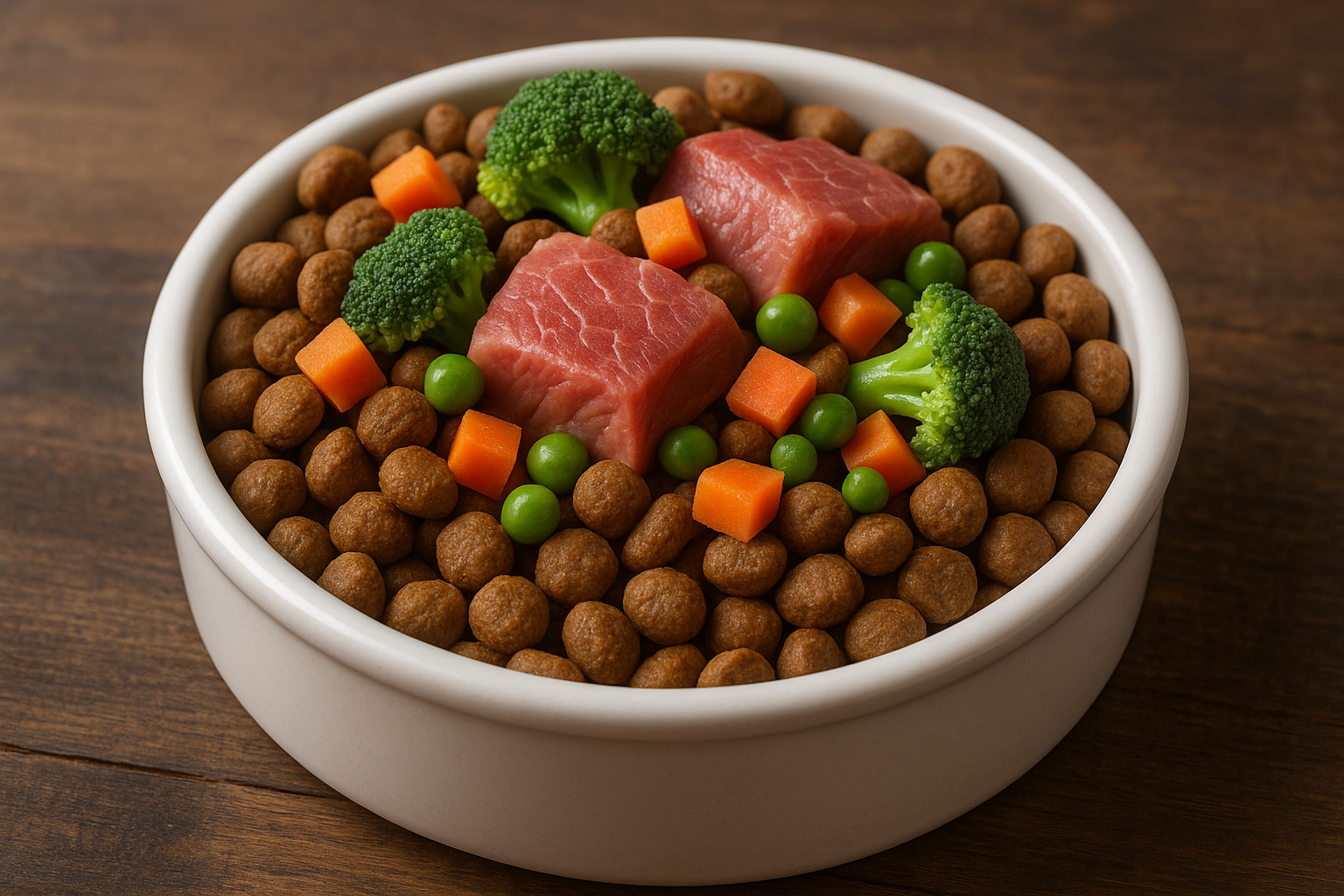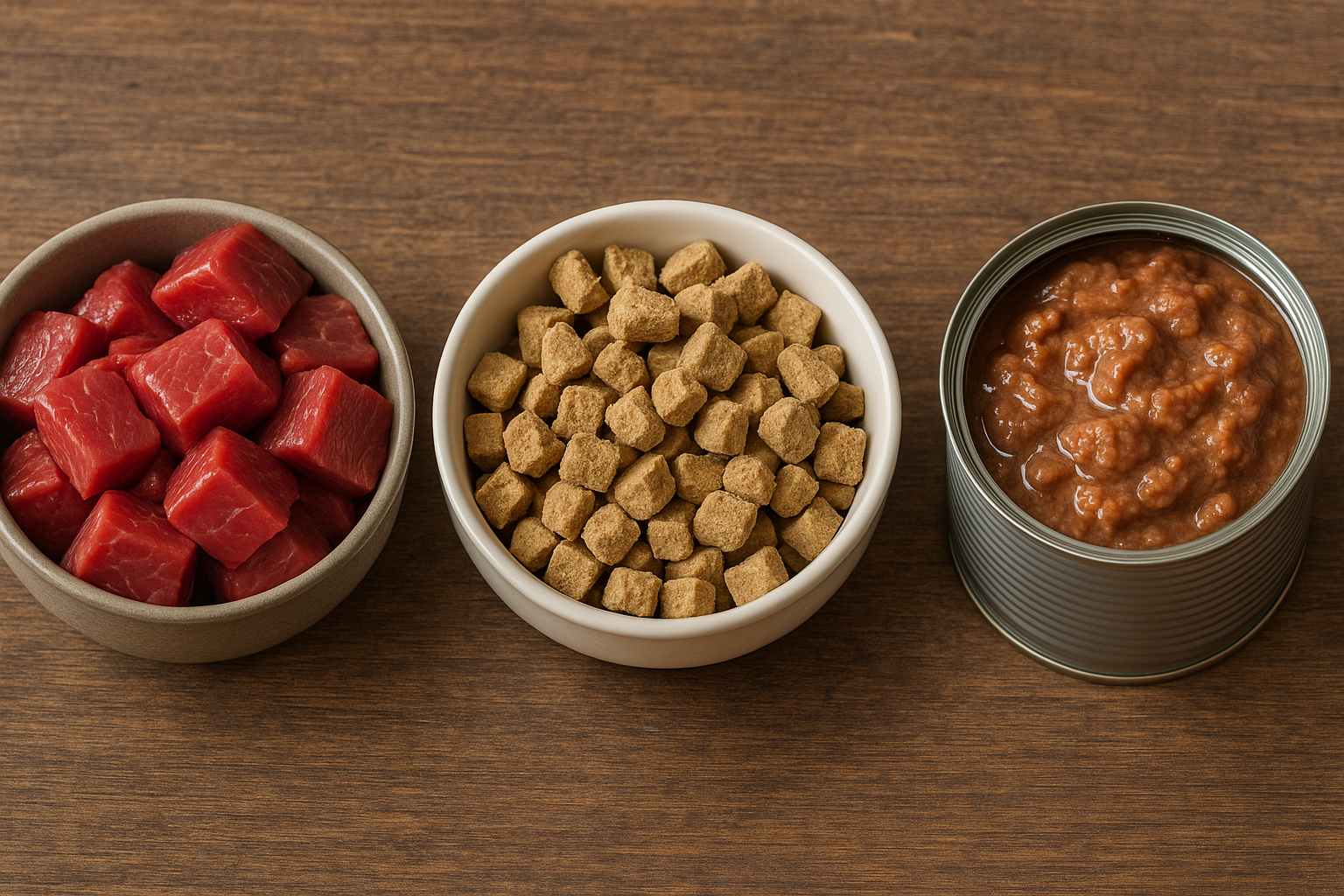Dogs thrive on a balanced diet.
But what defines the perfect bowl?
Our ultimate dog food cheatsheet covers nutrients, types, and top brands.
Some are packed with high-quality proteins for muscle strength.
Some are enriched with omega fatty acids for skin and coat health.
Some focus on grain-free, limited-ingredient formulas for sensitive pups.
Some blend superfoods like turmeric and cranberries for added antioxidants.
Some cater to every life stage, from playful puppies to wise seniors.
Let's dive right in.
Why the Right Dog Food Matters
Every dog owner knows that tail wags and bright eyes often reflect good health. In 2024, U.S. households spent over $45 billion on pet food and treats, according to the APPA National Pet Owners Survey, highlighting how crucial nutrition is for our furry family members. Yet, beneath colorful packaging lie complex formulas that can make choosing the right dog food a daunting task. From wrestling with label jargon to navigating the debate over grains, each decision can directly affect your dog’s vitality, digestion, and lifespan. For an even more comprehensive guide to decision-making strategies in any field, explore expert resources. This section unpacks why quality ingredients, precise formulations, and reputable brands form the foundation of every healthy meal.
Understanding Dog Food Nutrition Basics
Dog food isn’t just kibble or canned meat—it’s a science-driven blend of macronutrients and micronutrients that fuel your dog’s daily life. According to European standards in the FEDIAF Nutritional Guidelines, dogs require specific ratios of proteins, fats, carbohydrates, vitamins, and minerals to thrive. Let’s break down these essentials:
- Proteins: The building blocks for muscles, organs, and immune cells. Adult dogs need at least 18% protein in their diet, while growing puppies benefit from up to 22%. Premium sources include real meats like turkey, salmon, and beef. Low-quality proteins, such as meat by-products, can lack essential amino acid profiles and digestibility.
- Fats: Concentrated energy sources that support brain function, healthy skin, and a glossy coat. Dogs thrive on omega-3 and omega-6 fatty acids, found in fish oil and flaxseed. A minimum of 5% fat is recommended for maintenance diets, rising to 8% or more for puppies.
- Carbohydrates: Provide energy and fiber for healthy digestion. Whole grains like brown rice and oats, along with vegetables like sweet potatoes, are preferable to fillers like corn or wheat. Carbohydrate levels generally range from 30% to 60%, depending on formula and dog activity level.
 Micronutrients—vitamins and minerals—though required in smaller amounts, are equally vital:
Micronutrients—vitamins and minerals—though required in smaller amounts, are equally vital:
- Vitamins: Vitamin A for vision, vitamin D for calcium absorption and bone health, and B-complex vitamins for energy metabolism.
- Minerals: Calcium and phosphorus for skeletal strength; zinc and selenium for antioxidant defense and immune support.
Manufacturers following FEDIAF’s peer-reviewed standards and the AAFCO nutrient profiles ensure formulas are complete and balanced. Tali’s recipes exceed these benchmarks, combining human-grade ingredients with veterinary guidance to deliver each macro and micro component just right.
Types of Dog Food
With so many formats on the market, understanding each type’s pros and cons helps you match your dog’s preferences and needs.
Dry Kibble
Crunchy, convenient, and cost-effective, dry kibble remains the market leader. Premium kibbles avoid artificial preservatives and emphasize named meat sources:
- Tali Organic Salmon & Sweet Potato: Wild-caught salmon, organic sweet potatoes, and added probiotics for gut health.
- Tali Turkey & Brown Rice: Free-range turkey, brown rice, and a glucosamine blend for joint support.
Wet/Canned Food
High moisture content benefits hydration and palatability. Though pricier per serving, wet food can be crucial for dogs with dental issues or those who eat less when dehydrated. Many owners mix a spoonful of premium stews into kibble for variety.
Raw and Freeze-Dried Diets
<
Advocates believe raw-feeding mimics ancestral diets, promoting lean muscle mass. Freeze-dried dog food options offer shelf stability with raw-like nutrition when rehydrated. In a recent survey, 85% of dogs preferred Tali’s Freeze-Dried Salmon & Mango recipe over standard kibble.
Sources Ask ChatGPT
 Reading and Understanding Dog Food Labels
Reading and Understanding Dog Food Labels
Labels can be confusing. The AAFCO pet food label guide outlines required and optional labeling. Here’s what to watch for:
- Ingredient List: Items listed by weight—fresh meat may contain high moisture, so look beyond the first ingredient. Watch for fragmented fillers like “corn gluten meal” nested among proteins.
- Nutritional Adequacy Statement: Confirms the formula meets AAFCO nutrient profiles for specific life stages (e.g., “all life stages” or “growth & reproduction”).
- Guaranteed Analysis: Minimum crude protein and fat percentages, plus maximum crude fiber and moisture levels. This section normally resides near the ingredient list.
- By-Product Definitions: Not all by-products are bad; organ meats can be nutrient-dense. However, vague terms like “animal digest” may conceal low-quality sources.
How to Choose the Best Dog Food
Selecting the right diet means balancing nutrition with your dog’s unique profile.
Life Stage and Breed Considerations
Puppies need higher protein and calorie concentrations to fuel growth—look for formulas with 22% or more protein.
Adult dogs benefit from balanced maintenance diets to preserve lean mass.
Seniors require joint-support nutrients like glucosamine, chondroitin, and often fewer calories to prevent weight gain.
Large breeds, such as Great Danes, need controlled calcium levels for proper bone development, while small breeds do best with appropriately sized kibble for easier chewing.
Health Conditions and Special Diets
Dogs with allergies, obesity, diabetes, or kidney disease may need tailored nutrition:
- Hypoallergenic: Limited-ingredient or novel-protein diets (e.g., Tali’s Turkey & Pea formula) reduce allergic reactions.
- Weight Management: High-fiber, low-fat recipes help curb calories and support glycemic control.
- Renal Support: Formulas lower in phosphorus and protein levels adjusted for kidney health.
Real-World Example
Max, a nine-year-old Labrador retriever prone to hip dysplasia, thrived after switching to Tali’s Beef & Pumpkin Blend. Within six weeks, his joint stiffness eased thanks to green-lipped mussel powder and added glucosamine. His stool volume also decreased, reflecting improved nutrient absorption.
Benefits of Premium Dog Food
Investing in a high-quality formula often yields long-term health dividends.
- Enhanced Digestion: A study in the Journal of Animal Science found dogs fed high-protein, grain-free diets produced 20% smaller, more nutrient-dense stools—indicating superior digestibility.
- Healthier Skin & Coat: In a 2023 canine dermatology survey, 78% of owners noticed shinier coats and fewer hot spots after switching to premium recipes rich in omega fatty acids.
- Stronger Immunity: Superfoods like cranberries and turmeric deliver antioxidants, reducing inflammation and bolstering defenses against infections.
Top Picks from Tali’s Dog Food Collection
Tali’s commitment to human-grade, ethically sourced ingredients shines in these flagship offerings:
Organic Salmon & Sweet Potato Recipe
- Protein: Wild-caught Pacific salmon
- Carbs: Organic sweet potatoes
- Extras: Omega-3s, probiotics, green-lipped mussel for joints
- Best For: Dogs with sensitive skin or digestive issues
Turkey & Brown Rice Formula
- Protein: Free-range turkey
- Carbs: Brown rice, peas
- Extras: Glucosamine, chondroitin, B vitamins
- Best For: Active adults needing balanced energy
Beef & Pumpkin Blend
- Protein: Grass-fed beef
- Carbs: Organic pumpkin, lentils
- Extras: Vitamin E, zinc, antioxidants
- Best For: Seniors requiring gentle digestion and joint support
Transitioning Your Dog to a New Diet
A gradual switch minimizes gastrointestinal upset. Follow this 7–10 day plan:
- Days 1–2: 25% new food, 75% old food
- Days 3–4: 50% new, 50% old
- Days 5–6: 75% new, 25% old
- Day 7+: 100% new food
Monitor stool consistency, appetite, and energy levels daily. If you spot vomiting, diarrhea, or excessive scratching, pause and consult your veterinarian. Elimination diets with single-protein sources ease allergy detection.
Frequently Asked Questions
Q: How often should I feed my adult dog?
A: Most adult dogs do well on two meals per day. Portion sizes depend on weight and activity; follow Tali’s feeding chart or consult your vet.
Q: Are grain-free diets better?
A: Grain-free formulas benefit dogs with specific grain sensitivities. However, grains like brown rice can provide valuable fiber and nutrients. Consult a professional before making the switch.
Q: Can I mix wet and dry food?
A: Yes. Mixing enhances palatability and moisture intake. Adjust calorie counts to prevent overfeeding.
Q: Is organic dog food worth the extra cost?
A: Organic ingredients ensure non-GMO, pesticide-free sources. For dogs with allergies or digestive issues, these benefits often justify the premium price tag.
Q: How should I store dog food?
A: Keep kibble in a cool, dry place in its original sealed bag or an airtight container. Freeze-dried food should be resealed tightly, away from humidity.
Conclusion
Choosing the right dog food involves understanding nutritional science, label literacy, and individual dog needs. By focusing on high-quality ingredients, balanced macros and micros, and following best practices for transitioning diets, you set your canine companion up for long-term health and happiness. Visit Tali’s Dog Food Collection at https://talis-us.com/collections/dogs to explore these top-rated formulas and make the informed choice that elevates your dog’s vitality.
For ongoing insights and updates, check our Main Blog Page and discover new recipes.
from Talis Us - Blog https://ift.tt/AyPFxha









0 comments:
Post a Comment